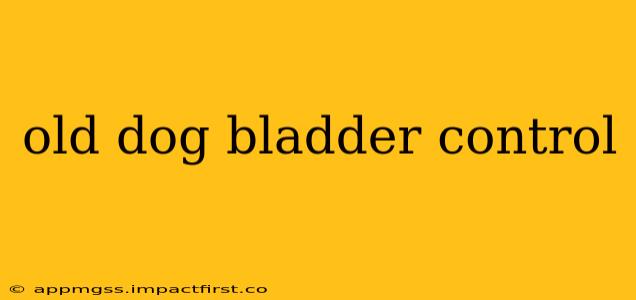Dealing with an older dog experiencing bladder control issues can be challenging for both the pet and their owner. Urinary incontinence in senior dogs is a common problem, but understanding its causes and available management options can significantly improve your dog's comfort and quality of life. This comprehensive guide will explore the various aspects of canine incontinence in older dogs, answering many common questions pet owners have.
What Causes Bladder Control Problems in Older Dogs?
Several factors contribute to bladder weakness and incontinence in senior canines. These can range from simple age-related changes to more serious underlying health conditions. Some of the most frequent causes include:
-
Age-Related Muscle Weakness: Just like humans, dogs experience muscle degeneration with age. The muscles responsible for holding urine in the bladder can weaken, leading to leakage. This is often the most common cause of incontinence in older, otherwise healthy dogs.
-
Hormonal Changes: Hormonal imbalances, especially a decrease in estrogen in female dogs, can impact bladder function and control. This is a significant contributor to urinary incontinence in spayed female dogs.
-
Urinary Tract Infections (UTIs): UTIs can irritate the bladder and lead to increased frequency and urgency, sometimes resulting in incontinence. While UTIs are more common in younger dogs, they can certainly affect seniors.
-
Cognitive Dysfunction Syndrome (CDS): Similar to dementia in humans, CDS can affect a dog's ability to recognize and respond to the need to urinate, leading to accidents.
-
Spinal Cord Issues: Conditions affecting the spinal cord, such as intervertebral disc disease (IVDD), can disrupt nerve signals to the bladder, impairing its function.
-
Other Medical Conditions: Kidney disease, diabetes, and certain types of cancer can also contribute to incontinence.
What are the Signs of Urinary Incontinence in Older Dogs?
Recognizing the signs of incontinence is crucial for early intervention. Common symptoms include:
- Frequent urination: Your dog may urinate more often than usual, even at night.
- Leaking urine: Accidental urination, especially while resting or sleeping.
- Dribbling urine: A constant or intermittent dripping of urine.
- Urine scalding: The fur around your dog's genitals may be constantly wet and irritated.
- Increased thirst: This could indicate underlying health problems contributing to incontinence.
How is Urinary Incontinence Diagnosed in Older Dogs?
A veterinarian will conduct a thorough examination, including a physical exam, urinalysis, and possibly blood tests to determine the underlying cause of your dog's incontinence. Imaging tests, such as X-rays or ultrasounds, might be necessary to rule out structural problems.
How is Urinary Incontinence Treated in Older Dogs?
Treatment options depend heavily on the underlying cause. For age-related muscle weakness or hormonal imbalances, medication is often the first line of treatment. These medications may include hormone replacement therapy for female dogs or medications to increase bladder tone. In cases of UTIs, antibiotics are usually prescribed. For dogs with cognitive dysfunction, supportive care and environmental modifications can be helpful. Surgery may be considered in some cases, particularly if there's a structural problem.
What are Some Management Strategies for Old Dog Bladder Control?
Beyond medical treatment, several management strategies can help improve bladder control:
- Frequent potty breaks: Taking your dog out more frequently, especially at night, can help prevent accidents.
- Controlled access to water: Restricting water intake, especially at night, can reduce the volume of urine produced.
- Belly bands or diapers: These can help contain urine leaks and keep your dog clean.
- Elevated food and water bowls: This can ease digestion and reduce pressure on the bladder.
- Regular exercise: Maintaining a moderate level of physical activity can improve muscle tone.
Can Dietary Changes Help with Bladder Control in Older Dogs?
In some cases, dietary adjustments can be beneficial. Reducing sodium intake can help minimize fluid retention, and certain dietary supplements may help support bladder health. Always consult your veterinarian before making significant dietary changes.
What are the Long-Term Outlook and Prognosis?
The long-term outlook depends on the underlying cause of the incontinence. With appropriate management, many dogs can maintain a good quality of life, even with incontinence. Early diagnosis and treatment are crucial for the best possible outcome. Regular veterinary checkups are essential to monitor your dog's condition and adjust treatment as needed.
This information is for educational purposes only and does not replace professional veterinary advice. If your senior dog is experiencing bladder control issues, it is essential to consult your veterinarian for a proper diagnosis and treatment plan. Early intervention is key to managing incontinence and improving your dog's comfort and well-being.
